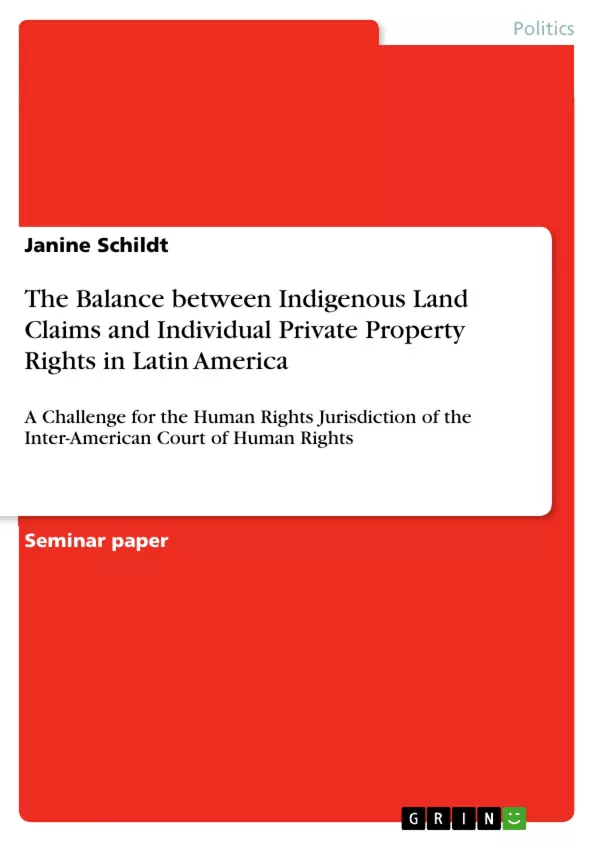How can indigenous property rights be guaranteed in today’s societies? In many countries with a large indigenous population this is an ongoing political struggle at the center of which stands the question how to balance traditional indigenous land rights and modern private property rights. The UN Declaration on the Rights of Indigenous Peoples was initially not signed by Canada, USA, New Zealand and Australia. The countries argued inter alia that the article on indigenous land rights could not be brought in accord with their domestic legislation and the private property rights they have to protect. In international law no common standard for indigenous land rights exists and individual countries have found different approaches in their domestic legislations often subordinating indigenous rights or restricting them on various grounds. Frequently, indigenous collective claims are weakened because legislation only recognizes individual rights to property as legitimate.
The Inter-American Court of Human Rights (IACtHR) has evolved a firm protector of indigenous land rights. In its landmark decisions Mayagna (Sumo) Awas Tingni Community vs. Nicaragua (2001), Moiwana Community vs. Suriname (2005), Yakye Axa vs. Paraguay (2005), Sawhoyamaxa vs. Paraguay (2006) and Pueblo Saramaka vs. Suriname (2007) it has underlined that traditional collective land rights fall under the protection of property in the American Convention on Human Rights (ACHR) and are thus equivalent to individual private property rights. This paper will look at the role of the IACtHR in the protection of indigenous land rights in Latin America and will discuss how it confronts the balancing problem between the two forms of property rights. Thereby, it is argued that especially because the challenge stays unresolved in many Latin American countries, the implementation of the progressive decisions of the IACtHR is frequently delayed.
Inhaltsverzeichnis (Table of Contents)
- Introduction
- The History of Indigenous Land Claims
- The Difficulty of Property Rights Definition
- Indigenous Property Rights and the IACtHR
- Balancing of Indigenous Land Rights and Private Property - the IACtHR Approach
- Conclusion
Zielsetzung und Themenschwerpunkte (Objectives and Key Themes)
This paper analyzes the role of the Inter-American Court of Human Rights (IACtHR) in protecting indigenous land rights in Latin America. It examines the challenges of balancing traditional indigenous land rights with modern private property rights and explores the implementation of the IACtHR's progressive decisions in various Latin American countries.
- The historical evolution of indigenous land claims in Latin America.
- The challenges of defining and securing property rights, particularly in relation to indigenous communities.
- The role of the IACtHR in protecting indigenous land rights through its landmark decisions.
- The balancing act between indigenous land rights and private property rights, as exemplified by the IACtHR's approach.
- The difficulties in implementing the IACtHR's decisions and the ongoing challenges in resolving the land rights conflict.
Zusammenfassung der Kapitel (Chapter Summaries)
- Introduction: This chapter outlines the central issue of balancing indigenous land rights and private property rights in Latin America, emphasizing the international legal context and the IACtHR's role in protecting indigenous rights.
- The History of Indigenous Land Claims: This chapter examines the historical evolution of indigenous land claims in Latin America, highlighting the impact of colonialism, the imposition of Western property concepts, and the challenges faced by indigenous communities in securing their land rights.
- The Difficulty of Property Rights Definition: This chapter delves into the complexities of defining property rights, exploring the tension between Western legal notions and indigenous perspectives on land ownership and usage. It also discusses the impact of competing interests, such as private companies and government development projects, on indigenous land rights.
- Indigenous Property Rights and the IACtHR: This chapter focuses on the role of the IACtHR in protecting indigenous land rights through its jurisprudence, highlighting the court's reliance on both property rights and the right to cultural survival.
Schlüsselwörter (Keywords)
This paper examines the key concepts of indigenous land rights, private property rights, the Inter-American Court of Human Rights, the American Convention on Human Rights, and the challenges of reconciling diverse legal and cultural perspectives on land ownership and usage. It explores the tensions between individual and collective property rights, the historical legacy of colonialism, and the implementation of international legal standards in Latin America.
- Quote paper
- Janine Schildt (Author), 2009, The Balance between Indigenous Land Claims and Individual Private Property Rights in Latin America , Munich, GRIN Verlag, https://www.grin.com/document/159973



